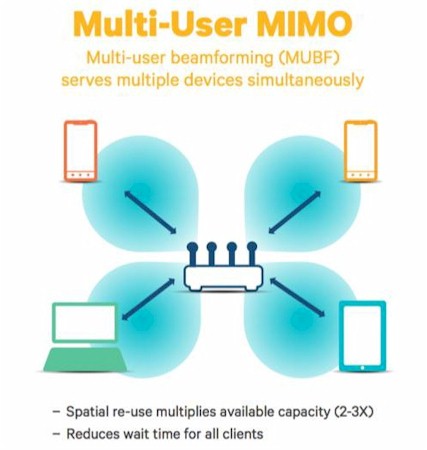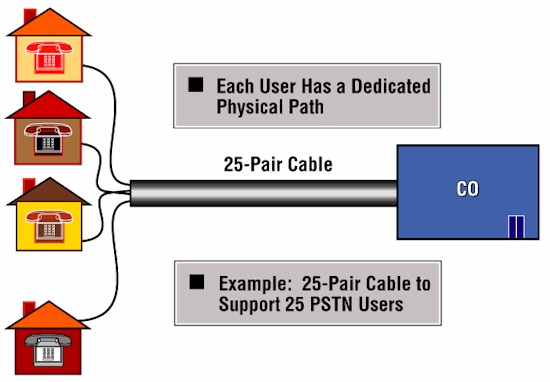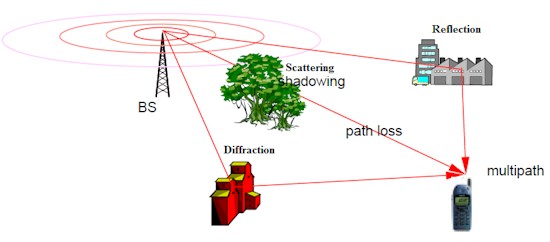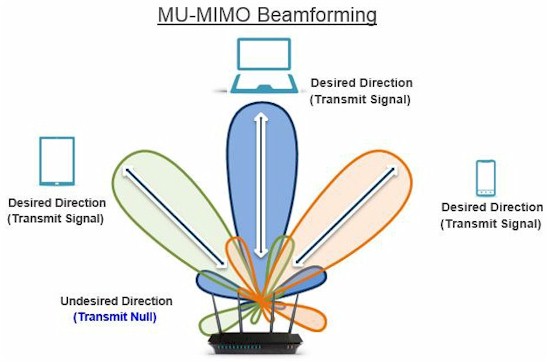This article is sponsored by Qualcomm Atheros, Inc. & Linksys.
To understand how MU-MIMO increases your total wireless bandwidth, a little background helps. You’ll often see the terms "streams" or "spatial streams" used in descriptions of today’s MIMO-based wireless routers. These refer to a technique called space-division multiplexing (SDM) or space-division multiple access (SDMA). This technique uses multiple physical paths to establish separate bandwidth channels.

A simple way to visualize this is to picture a telephone cable, which contains multiple twisted-wire pairs to connect subscribers. Since each subscriber has his / her own dedicated connection, simultaneous communication can occur on all wire pairs at the full bandwidth supported by each pair. In this case each wire pair is a "stream".

Space Division Multiplexing – wired
(image credit: Hill Associates)
In MIMO (multiple input multiple output) systems, the physical paths become the space between the multiple antennas used. Antenna separation was used even in single radio 802.11b/g non-MIMO routers, which often had two antennas for signal diversity to combat multipath. Multipath causes radio signals to be received via more than one path as illustrated below. When receiving, the non-MIMO router would sample the signal from each antenna and use the better of the two.

Wireless multipath
802.11n MIMO systems use antenna separation and multiple radio receiver / transmitter pairs ("chains") to turn signal multipath to an advantage. Through complex calculations, the phase (timing) and amplitude of signals from up to four streams created by the radio chains are combined to increase effective receiver gain. With increased gain, weak signals that previously were not reliable enough to transmit data now can, and stronger signals are boosted enough to increase effective data rate.
802.11n also introduced beamforming, a technology that further enhances wireless spatial streams by focusing a wireless router or access point’s (AP) transmit energy toward specific client devices. Higher energy improves connection quality enough to enable using modulation techniques resulting in higher data rates.
Beamforming can be implemented by the router / AP only (aka "implicit" beamforming). But more effective forms (aka "explicit" beamforming) require client devices to also support beamforming and participate in a "sounding" transmission that learns about the connection between AP and client. This allows the AP to more effectively form its beam when actual data is sent to the client. Unfortunately, 802.11n didn’t specify a single standard beamforming method, so it had limited effect.
802.11ac increased the maximum number of MIMO streams from four to eight to enable even higher data rates. But both router and client need to support the same number of radio chains to achieve full MIMO benefit. This is not practical for client devices that must be smaller and more power efficient than wireless routers. Since wireless clients typically contain one or maybe two radio chains, single user MIMO’s (SU-MIMO) higher bandwidths most often go untapped.
This is where MU-MIMO comes to the rescue. 802.11ac specifies a standard beamforming method and also an enhanced form that supports up to four simultaneous directional radio links. So where 802.11n’s SU-MIMO can talk to only one client at a time, 802.11ac’s multi-user MIMO (MU-MIMO) supports simultaneous data transmission to up to four. Extensive research and testing found, however, that three simultaneous streams produced the best overall throughput utilization in typical indoor environments for a 4×4 AP / router.

MU-MIMO beamforming
MU-MIMO’s benefits don’t stop at three clients, however. When more than three MU-MIMO clients are present, clients can be grouped by traffic type to optimize transmission efficiency. And intelligent airtime scheduling can increase the total number of clients supported by a single AP or router. Qualcomm® Atheros’ MU-MIMO research has enabled a single AP using Qualcomm® MU | EFX technology to improve total throughput capacity up to 3X for 1×1 clients and 2X for 2×2 clients.
Why Wait™ any longer to make the jump to MU-MIMO? Linksys’ EA8500 Max-Stream AC2600 MU-MIMO Smart Wi-Fi Router powered by Qualcomm® MU | EFX technology is here now.

 Read more about Linksys.
Read more about Linksys.